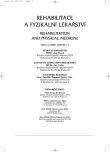Relationship betweem Breathing Movements and Posture
VZTAH MEZI DECHOVÝMI POHYBY A DRŽENÍM TĚLA
Stále více se ukazuje, že držení těla úzce souvisí s bolestmi zad. Změny držení těla mají za následek změnu dechového vzoru a rovněž změnu stabilizace trupu. Bránice má významnou stabilizační funkci. Náš příspěvek osvětluje reakci bránice na změnu držení těla tak, jak ji můžeme vidět na záznamu magnetické rezonance. Ukazuje, že při změně polohy hlavy dojde vždy ke změně postavení bránice a jejího následného dechového pohybu.
Klíčová slova:
držení těla, bránice, dechový pohyb hrudníku, sterna a břišní stěny, magnetická rezonance
Authors:
J. Čumpelík 1; F. Véle 2; M. Veverková 3; P. Strnad 2; A. Krobot 4
Authors‘ workplace:
Národní divadlo, Praha
1; Fakulta tělesné výchovy a sportu UK, Praha
2; Institut postgraduálního vzdělávání ve zdravotnictví, Praha
3; Klinika rehabilitačního a tělovýchovného lékařství LF UK a FN, Olomouc
4
Published in:
Rehabil. fyz. Lék., 13, 2006, No. 2, pp. 62-70.
Category:
Original Papers
Overview
There is increasing evidence that stability and posture are connected with the back pain. The clinical experience of the postural stability shows that there is a link between the breathing mechanisms and posture. Our contribution shows how the diaphragm, seen in the diagram of magnetic resonance, reacts to the changes in the posture. When we change the position of the head we get always different response of the diaphragm in the position and following process of the breathing movement.
Key words:
posture, diaphragm, movements of the chest, MRI
Labels
Physiotherapist, university degree Rehabilitation Sports medicineArticle was published in
Rehabilitation & Physical Medicine

2006 Issue 2
- Hope Awakens with Early Diagnosis of Parkinson's Disease Based on Skin Odor
- Deep stimulation of the globus pallidus improved clinical symptoms in a patient with refractory parkinsonism and genetic mutation
Most read in this issue
- Relationship betweem Breathing Movements and Posture
- Disorders of Cervicothoracic Junction and Distant Symptoms
- New Knowledge about Structural Prerequisites in Coordination of the Diaphram Function and Belly Muscles
- Shoulder Girdle in the Regiment of Quadrupedal Locomotion
